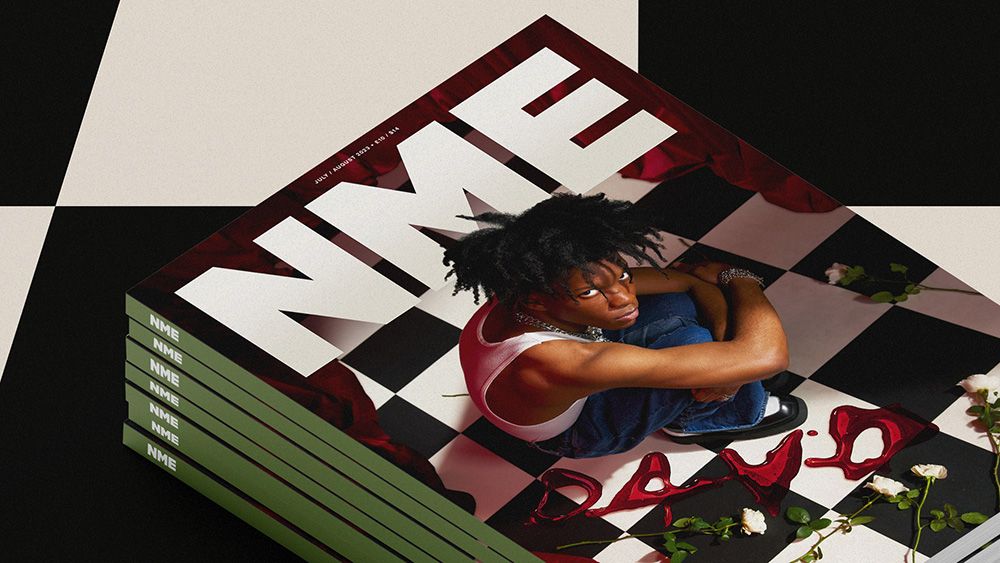NME Relaunches Print Magazine With Limited Drops, Emerging Artists
Iconic music publication NME is relaunching its print magazine.
After shutting down production in 2018 to focus on its digital presence, the brand will return as a global bimonthly magazine with a July/August issue featuring fast-rising indie singer-songwriter D4vd. Each issue will focus on an emerging artist as part of NME’s commitment to music discovery, and a limited number of copies will be sold via select partners (starting with music retailer Dawsons on Aug. 9) to enact what NME Networks COO Holly Bishop calls a “high-hype model.”
“We believe there’s value in scarcity, and you really see this in the hype and buzz that’s created in the fashion world, particularly around sneaker drops. We’re taking a similar approach to the magazine,” Bishop, who has worked in publishing at NME for 10 years, tells Variety. “Of course, we want the brand to be accessible … but there really is something valuable in delivering a product that’s hard to get your hands on.”
One of the most historic titles in music journalism, the U.K.-based New Musical Express was founded in 1952 and quickly became a tastemaker, helping propel British acts from the Rolling Stones to the Sex Pistols, U2, Blur and Oasis to worldwide fame. Now, in a media landscape where print publications are growing scarcer by the day, Bishop cites NME Networks’ acquisition by Caldecott Music Group in 2019 as one of the factors that will allow for NME to create a magazine that isn’t driven solely by profit.
“We aren’t relaunching the magazine to build an audience of hundreds of thousands of print readers, or even to drive substantial newsstand revenues,” she says. “Instead, it’s going to be about super-serving our super fans through that physical medium, and creating a pop-culture bible to capture a moment in time.”
As vinyl has seen a remarkable resurgence in the past decade, Bishop is hopeful that the same will ring true of NME’s physical print product. Below, Bishop talks more in-depth with Variety about relaunching the magazine, its non-traditional strategy and what readers can expect from the first issue.
How did this relaunch come to be?
We’ve toyed with the concept of bringing print back to market probably since NME was acquired back in 2019. Over the last six months, we wrapped up those conversations and it felt like the time was right. We know NME has an incredible print legacy, it’s arguably one of the most recognized music titles on earth in print. We’ve had the biggest icons across pop culture gracing our cover, but it’s obviously no secret that in the digital world we’re now in, print is facing challenges on all fronts — not just in terms of audience engagement, but on the production side too, which isn’t helped by market conditions.
But we’re part of Caldecott Music Group now, which changes the shape of the business, and as a group we believe that in order to be successful and sustainable, a brand needs to authentically connect with an audience across social, digital and physical platforms. Print provides yet another physical gateway to the brand and the frequency of it means that we have that regular touchpoint. We’re inspired by the incredible resurgence we’ve seen in vinyl and — dare I say it — cassette tapes, and that’s really shifted over the last few years. For me, this demonstrates that our multigenerational audience, they’re not 100% digital natives like we may be led to believe. They still really care about the quality of experience that only physical media can bring.
As you know, print media has been waning for a long time now. Why relaunch in this current climate? How do you plan to make sure the magazine is profitable?
Obviously, print is a traditional platform, but we’re very much approaching it in a non-traditional way. [Being part of] Caldecott Music Group really strengthens our position further because as a group, NME sits alongside brands like BandLab, Harmony, Heritage Guitars and Mono, among others. With our print proposition, we’ve fundamentally shifted away from an advertising and newsstand model and instead, we’ve really taken it back to focusing on creating a product that will add value for NME super fans and also immortalize the emerging artists that we select for the cover in the way that only print can. That diverse mix of brands and products ensures we’re more resilient to the market conditions, which means we can continue investing and it’s not necessarily about driving the profit out of one particular product at any particular point of time.
There’s no greater way in illustrating the connectivity across the group than with our debut global print cover, which is fronted by D4vd. D4vd actually started making music in his sister’s closet using BandLab and made this entire album on the platform, and we have been following D4vd’s journey right from day one with insight that we gleaned from BandLab.
How did you decide what will be featured in the magazine vs. online? What can you tease about its redesign?
There will be some content that will also be available on dot com, but it’s been reformatted for print and there will be some print exclusives in there. We’ll be featuring and interviewing the biggest names in music and pop culture, but from the cover perspective, that’s now exclusively reserved for emerging and that’s consistent across all our channels.
It’s going to look quite different from any of our previous copies, even in the quality of the print itself. The design is fun and fresh. You can expect to see all of the verticals that we editorially cover on dot com integrated into the magazine — music, film, TV, gaming. There’s also going to be some industry features that will land exclusively first in print, which is a chance for music and pop culture fans to get to know some of the people that are changing the shape of our industry.
Why drop only a limited amount of issues?
We believe there’s value in scarcity, and you really see this in the hype and buzz that’s created in the fashion world, particularly around sneaker drops. We’re taking a similar approach to the magazine. Of course, we want the brand to be accessible and we know we’re engaging with more music and pop culture fans than ever before across NME.com, but there really is something valuable in delivering a product that’s hard to get your hands on.
Again, from a distribution standpoint, we’re uniquely positioned as a group. We recently announced the acquisition of U.K. music retailer Dawsons, and Dawsons draws some great parallels with NME, it’s got a really rich heritage that spans over 120 years. This print launch will see us drop online at Dawsons.co.uk, as well as drops by talent featured in the magazine through brand partners — but really following that high-hype model you see in the fashion world. I feel it’s more sustainable, too, because we’re not churning out hundreds of thousands of magazines that may or may not be purchased at newsstands. We know it’s getting into the hands of the super fans, and that’s really important for the artists on the cover and within the issue.
NME was the must-have mag for any music fan. How do you plan to revive that sort of fanbase in the digital age?
NME is and will continue to be a music-led brand, there’s no denying that. We aren’t relaunching the magazine to build an audience of hundreds of thousands of print readers, or even to drive substantial newsstand revenues. Instead, it’s going to be about super-serving our super fans through that physical medium and creating a pop-culture bible to capture a moment in time and also, most importantly, providing artists an opportunity to connect with new audiences around the world.
What do you hope this relaunch means in terms of the state of print journalism, specifically within music?
It’s a show of strength to bring back such an iconic brand in the print space and to do it in a way that no one else is. So hopefully, in the same way that we’ve led the charge for 70 years, we will continue to do so. There’s hope that others may follow and it provides a new and sustainable model for media.
This interview has been edited and condensed.
Source: Variety


